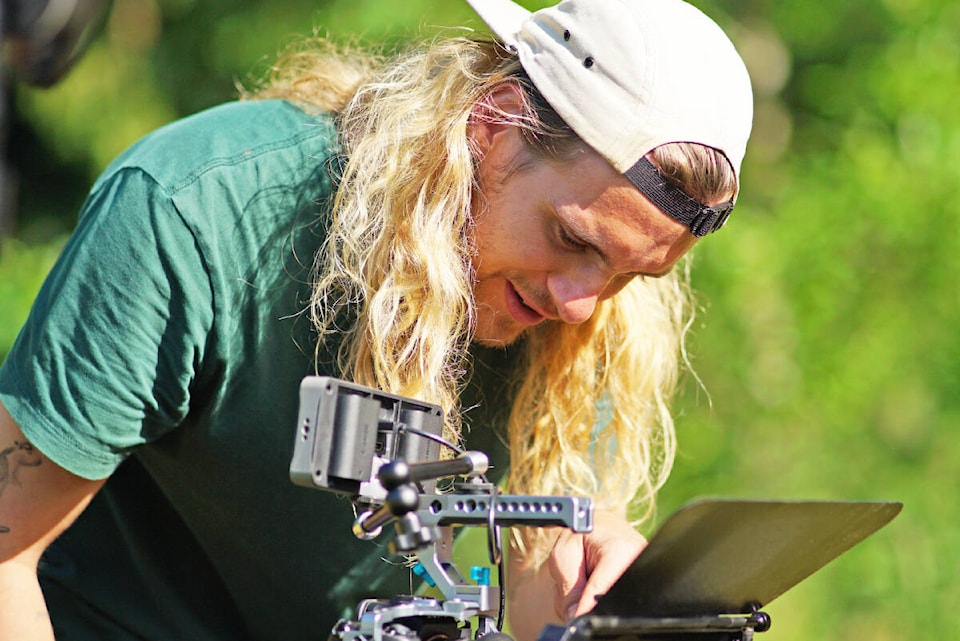Olive is small and a little grumpy. She’s kind of a matriarch figure to the people in her little community outside of Quesnel. Those feelings deepened when word got around that she saved her best friend from a bear attack. She wanders where she likes, is adored openly by all she meets, and shows everyone around what it means to form meaningful bonds. People call her an “unexpected force.”
Olive is 12.
Olive is a dog.
Olive is also the real-life star of a new film about to be seen by the nation on April 19 on CBC Gem.
Block Dog is the latest documentary directed by Everett Bumstead of Here Boy Films (the creative minds behind hit docs One Million Trees and Stewards). He wanted Quesnel to know the community was about to co-star in the spotlight with this special canine companion for the treeplanters she was there to guard.
“I think most people who have ever had a pet, wonder what their dog gets up to at home while they’re at work, or what their outdoor cat is actually doing when it leaves home for hours at a time. When I was working as a tree planter (2012 - 2017), I had this same curiosity about the dogs we had in camp,” said Bumstead.
In Bumstead’s experience, there was always a gaggle of dogs on-site when the treeplanters were doing their focused wilderness work. They were the alarm system for predators, but also the companions of the crews who were in that unique employment setting. Bumstead’s nose for a good story led him to his protagonist, Olive.
“To make it on the cut-block, a dog must be very well trained, well behaved, agile, adaptable and potentially prepared for deadly conflict with a wild animal. These dogs are warriors,” he told The Observer. “So we chose these dogs to focus the narrative on because they live real, unfiltered lives. They have real relationships with one another, real drama, real struggles. They are out there in the real world - from cut-blocks to forests, mountains to swamps - experiencing the natural parts of this country that so few humans or dogs ever get to experience.”
He recalled conversations over the course of his treeplanting career that painted a compelling picture of how these dogs convey the full drama of human life. They are central to comedy, affection, resourcefulness, playfulness, and at least a dozen lives saved from predator threats that he knew of. It was a perfect script because there was no need for a script - all natural.
“Compared with my experiences filming human subjects, filming and editing dog characters was like a breath of fresh air,” Bumstead said. “People can be so guarded. The treeplanters themselves are typically pretty open people. But they are also people who choose to work in remote areas, sometimes without access to the internet or technology for months at a time. So if you’re having a chat around a campfire with a treeplanter, no problem. But no one is taking any selfies in this kind of space.”
Therefore, a movie camera tends to trigger the turning of backs and the quieting of conversation. Except for the dogs, who do the opposite and come wagging straight at the camera crew as they hunch over for a strategic vantage point. Either way, it’s a filmmaking challenge.
“When we told the planters we were just there to film their dogs, however, suddenly taking out our cameras was greeted with smiles,” Bumstead said. “Rather than people being shy and avoiding us, they would tell us their ideas for a cool shot or they would want to share a story about one of the dogs and they quickly became our collaborators.”
And the Cariboo itself was a collaborator, as a silent character wherever the lens turned.
“I wouldn’t say we necessarily chose Quesnel, but Quesnel chose us. Tree planting has been bringing me to Quesnel for years and I appreciate it more each time,” Bumstead said. The same could be said for the film crew, whom he linked up with due to their own familiarity and experiences with the silviculture and forestry personality of the area.
“If you ask any experienced B.C. planters their favourite ‘day-off town,’ Quesnel will be at the top of their list. Not only for its amenities, but natural beauty, parks, rec centre, and people that treat you with respect when you come to town, even if you have a bit of dirt under your fingernails,” Bumstead said.
He and the production crew were inspired by films such as Andrea Arnold’s Cow (2021), Elizabeth Lo’s Stray (2020) and Ceyda Torun’s Kedi (2016), all of which feature animals as protagonists, and all are “small stories told with a gentle touch.”
When he would explain the concept, Bumstead said he was greeted with understanding and enthusiasm by virtually everybody needed to advance the project, including the content team at CBC Gem, who saw the intrinsically Canadian content it possessed.
Bumstead said he has a good feeling about the film festival circuit, as well, and not just in Canada, because dogs are human besties all over the world, and everyone responds naturally to a forest.
READ MORE: Cache Creek area stars in opening scenes of new TV series
READ MORE: Cariboo’s William Belleau feeling at home on Hollywood’s red carpet
